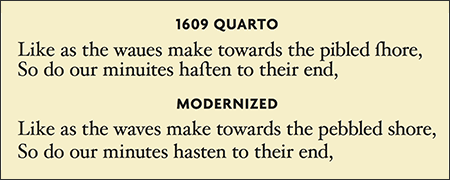
Shakespearean English can be problematic for modern readers. Standardisation of the language did not begin in earnest until the late 18th century. Some words had various spellings, all of which were considered normal at the time. Some words had meanings that have changed over the centuries. The letters ‘u’ and ‘v’ had not found their modern sounds. And perhaps most disturbing for modern readers, a second form of the letter ‘s’ – easily confused with an ‘f’ – was in universal use.
While our Petrarch Press editions are fine-press books that serve to enrich our personal reading experience, we also strive for textual accuracy. When we first contemplated printing a new edition of Shakespeare’s Sonnets, we asked ourselves, ‘How can we produce a book that combines formal beauty with scholarly integrity? What can we contribute that has not already been done?’
Every publisher of Shakespeare’s Sonnets must select the version they wish to print, and this is, of necessity an edited version. We began by seeking a text that would be accessible to modern readers, while also preserving as much as possible of the authentic flavour of the original text.
Initial Plan: Find a Good Existing Edition

At first, our plan was fairly simple. We wanted to include the Capitalised and Italicised words, to reintroduce some of the Early Modern spellings, and above all to respect Shakespeare’s punctuation, which, as we learned, was based on principles of rhetoric that governed both dramatic and lyric writings, and which differs from the grammatically-defined punctuation of today. And we set out to find an existing translation that came closest to these standards.
We began comparing numerous major editions of the Sonnets and researching their history, from the 1609 Quarto edition (the only publication of these sonnets during Shakespeare’s lifetime), through Edmund Malone’s 18th century emendations to the major scholarship of the 20th century (Oxford, Cambridge, Yale, Arden, Penguin…). Along the way, we were surprised to find that editors over the years had taken significant liberties in revising, editing, modernising, and “correcting” the text of the original.
Editors have generally standardised Shakespeare’s spelling and altered the punctuation to suit the conventions of their own time. Some, like Malone, even went as far as removing words that they found puzzling and substituting new ones that seemed more beautiful or appropriate, developing theories to explain why these words had not been printed in the Quarto.
The principal justification given by academics for emending the Quarto edition is that the printers of 1609 made mistakes. While Jacobean typesetters may have been granted the liberty to adjust their copy text, we are confident that they were quite capable of setting a line of type correctly. If we give these craftsmen some benefit of the doubt, it raises the question: what was the poet’s intention in using this spelling, that capitalisation or the other punctuation?
From our review, we were unable to locate any edition that reduced all these layers of changes to the degree we wanted. We realized we would need to produce our own edition of the text.
Next Plan: Modernise the Text, Respectfully

Of the editions we had already examined, that of John Dover Wilson (Cambridge University Press) came closest to our vision, and we agreed to use that as a starting point from which to build our own text. Our editing team began, line by line, word by word, to compare Dover Wilson’s text to the Quarto, to understand what further modernisations we wanted to remove.
Conventions for punctuating dramatic texts were already established in Shakespeare’s time – commas, semicolons, colons, and periods all indicated pauses of varying lengths – and we began restoring them to their original places. Modern usage joins some words together as compounds, but we wanted to separate them as they were in the Quarto: “an other”, “thy self”, “your self”, “every where”.
Other questions were trickier: for instance, how to modernise spelling without losing wordplay? ‘Heart’ is often spelled ‘hart’, thus echoing the legendary stag and otherworldly symbol. In Shakespeare’s play Twelfth Night, Orsino puns on hunting the hart in his desires for Olivia: and in Sonnet 24 the poet reminds us that emotions are invisible:
Yet eyes this cunning want to grace their art
They draw but what they see, know not the hart.
Variant spellings of the same word are not uncommon, even on the same line: “what good-turnes eyes for eies have done”. Should we change those to be consistent? After all, this was the raw material Shakespeare shaped into poetry.
A serious editorial question emerged: where should we draw the line? By adapting the text for the modern reader, we are removing layers of meaning present in the original form. Perhaps we need to demand more from our readers…
One day, at a Press general meeting, one of our patrons posed the question: “If we lose so much by editing Shakespeare’s text, why are we not printing the original text?” And we had to agree.
Final Plan: Return to the Original Text
Although we were relieved to drop the editorial burden of inserting our own opinions between Shakespeare and his reader (as so many have done before), we now faced substantial technical challenges and shifts in the design resulting from the choice of text. The separate story of the design of the Sonnets is told in Creating New Types for Shake-speare’s Sonnets.
From an editorial point of view, we would abandon our selective modernisations and begin again from the text of the 1609 Quarto edition. The primary questions then became: Were there any indisputable typographic errors in the 1609 edition? And how would we identify them?
In fact, there are barely a handful of undeniable typos in the Quarto imprint, and we confined our emendations to those: “Freeedome” cannot have three ‘e’s; “yeeare” also needs one less ‘e’; TThy is wrong; as are two commas together (“guift,,”). These are errors we corrected with confidence.
Even to the untrained eye, “Bare rn’wd quires” looks just wrong, but wait… the ‘w’ was once a vowel (double-u) in older English, and with the corrected spelling “rw’nd”, it suddenly becomes more readable as “Bare ruined choirs”!
Taking all of this into account, our changes to the Quarto text were few, and limited to correcting errors that ran counter to the sense. Wherever there was significant doubt as to a proposed correction, we stayed on the side of caution and left the original undisturbed. In the end, as shown in the printed insert below, we limited our emendations to seventeen throughout Shakespeare’s 154 sonnets. The rest of the text stands as it was printed in the 1609 Quarto.

Epilogue
We originally set out to print a fine-press book, and in the end we became entangled in an act of Shakespearean revival: bringing to light the depth and richness contained in the original spelling, punctuation and typography.
We came to understand that a reading of Shakespeare’s Sonnets becomes more complete when one can appreciate the Quarto. With this fresh canvas for Shakespeare’s most intimate and mysterious poems, it is our wish that this edition will instil a renewed appreciation both for the music of each individual sonnet and the sequence as a whole.
In retrospect, we were thus been able to reformulate our original aim: To produce a fine-press edition from the most authentic text of Shakespeare’s sequence of sonnets.
Related:
Shake-speare’s Sonnets
Creating New Types for Shake-speare’s Sonnets
